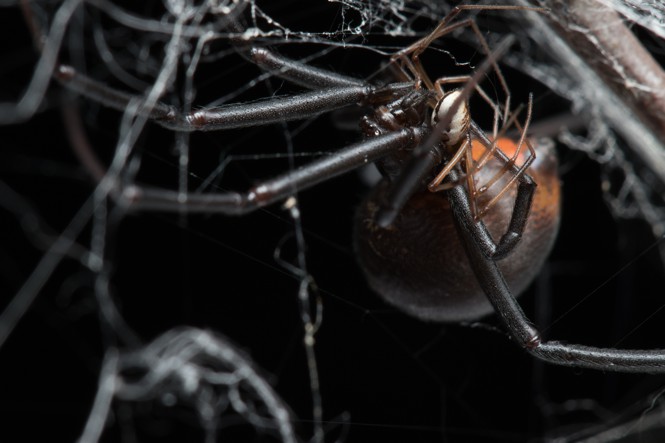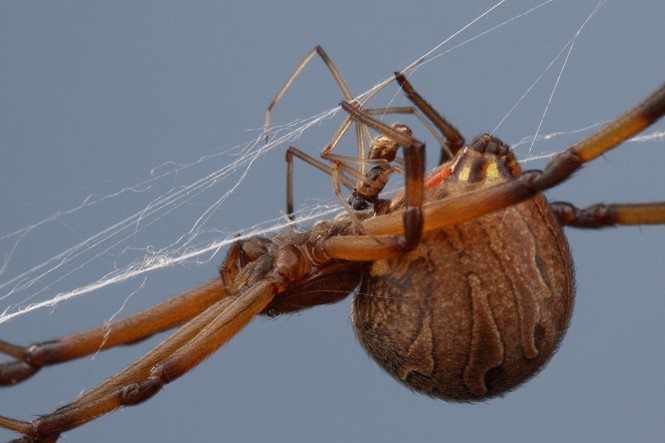
Among spiders, sex doesn’t just create life; it can also end it. Males of many species—including orb-weaving spiders, widow spiders, and wolf spiders—find their fortunes turning on a dime, as the females they’ve seduced begin to devour them alive, sometimes even before insemination is complete. Most eight-legged bachelors go to great lengths to avoid being eaten by their lover: Some try to massage her into a stupor, or bind her legs up with silk; others play dead, or detach their own legs to distract her with a precoital snack. It’s all in service of survival, so the male might live to mate another day.
Certain male widow spiders, however, have a very different view of these horrific meet-cutes. Within seconds of initiating intercourse, they’ll initiate a self-sacrificial somersault, flipping their back forward onto their mate’s mouthparts until she almost has no choice but to take a bite. Her fangs pierce the male’s body, flooding him with digestive enzymes that liquefy his innards; she then drains him like a Slurpee, leaving only an exoskeleton behind.
This macabre ritual wouldn’t happen if the male didn’t offer himself up. When their suitors don’t somersault, females don’t chow down—which makes some nutritional sense, considering that males in the two species where these acrobatics occur, redbacks and brown widows, weigh just 1 to 2 percent of what their mates do. “She would do better with a fly,” says Lenka Sentenská, a biologist at the University of Toronto. And yet males offer themselves willingly, almost insistently. Even when given the opportunity to couple with females that are less likely to cannibalize them, males will select the man-eating mates. “Basically, they are forcing the females to kill them,” Sentenská told me. In this murder, the male is both victim and accomplice, spinning a web of mystery around their leggy liaison.
[Read: A truly remarkable spider]
Maybe these bizarre acts of martyrdom aren’t as paradoxical as they seem. In the 1990s, Maydianne Andrade, Sentenská’s mentor at the University of Toronto, found that male redbacks that goad their mates into cannibalism copulate for longer than those that don’t—thanks to a quirk in their anatomy, they can keep transferring sperm into the female as they’re being consumed. The male deposits his semen into the female’s sexual organs using two long, armlike appendages near his head, called pedipalps. They can reach the underside of her body whether the partners are head-to-head or he’s flipped over and she’s draining the life out of his back. The longer the male multitasks, the more eggs he fertilizes; the tips of his pedipalps may also snap off, plugging the entrance to the pouch where the female stores sperm, and making it more difficult for another suitor to deposit semen inside.

A male’s greatest hope is to become a female’s first and only mate, essentially ensuring his paternity of her future kids, says Laura Sullivan-Beckers, a spider biologist at Murray State University. Encouraging cannibalism can solidify that fate in another way, too: Andrade has found that the redback females that nosh during their nuptials are also more apt to turn subsequent males away, reducing the odds that their first partner’s contributions end up diluted, and their brood paternally mixed.
Death still seems a high price to pay for a couple hundred eggs—but for male widow spiders, maybe it’s not. “Female widow spiders are really spread out in the environment, so males have to really work to find a mate,” Sullivan-Beckers told me. Most of them wander the landscape and die as virgins, never managing to locate a female at all. The few that do must then surmount a series of obstacles to initiate sex. To curry the female’s favor, males will shake, shimmy, and twerk on her web for up to 10 hours, then attempt to mount her before she mistakes her mate for prey. Ironically, all of their precopulatory efforts are in service of not getting eaten; priority No. 1 is communicating, “I am a male, not a meal,” says Catherine Scott, a biologist at the University of Toronto who works with Andrade and Sentenská.
Clearing all those hurdles once is impressive; twice or more, truly improbable. “The chances of finding a second female are next to nothing,” Scott told me, especially considering that males live for just a couple of months. Which means that most of them have little to gain by making it out alive: Longevity hardly matters if there’s no more sex to be had. “In that respect, reproduction is more important than survival,” says Mercedes Burns, a biologist at the University of Maryland at Baltimore County. Better to invest all you’ve got in your current prospect than to phone it in, only to have to risk it all again.
[Read: The world shifts when a black widow squats]
Some widow males actually survive long enough to copulate twice (twice!) with one mate if they play their cards right. Females each harbor two sperm-storage organs, which must be filled one at a time. To ladle his sperm into both, though, the male has to survive the first tryst—a feat that a redback can manage by cinching a portion of his abdomen, “as if by a belt,” Andrade told me, potentially shunting his organs away from his mate’s lethal bite. The fangs still puncture him, and the digestive process begins; by the time their second date is through, the female has finished the job.
Other males might not get eaten by their paramour at all. A few years ago, Andrade and her colleagues discovered that widow males can slash their risk of being cannibalized by mating with females in a late-juvenile stage. The act requires some finagling: In the days before they molt into adults, females’ genitals, although fully developed, remain cloaked beneath a sheath of exoskeleton that the male must slice through with his fangs. It sounds almost as barbaric as eating your mate, but in the long run, the females actually seem unharmed, says Luciana Baruffaldi, a biologist at the University of Toronto, also on Andrade’s team. The males, meanwhile, glean an obvious benefit: They only rarely somersault for subadults—and almost always emerge from sex unscathed.

It’s hard to imagine, at first glance, why any widow male would deign to mate with an adult female. But strangely, Andrade’s team has found that, at least in the lab, widow males actually seem to prefer their mates well aged, even when a younger alternative may be nearby. It’s as if, Scott told me, the males want to court an entirely avoidable death.
Part of this bias could just be the curse of chemistry: Adult females exude more pheromones, making them easier to find. But the reproductive calculus is also more complex than it seems. A subadult female, although capable of storing sperm, can’t use it to squeeze out an egg sac until after she has matured, which may take at least a week, possibly two. During that interregnum, she must also molt, a process that makes a spider easy prey, squishy and weak and slow. Mating with a subadult, then, “is actually not a sure thing,” Scott said. Should the sperm-toting female die before her brood is laid, the male’s efforts will all be for naught.
Opting for adults instead does put males at more risk of a truly grisly death—an outcome that seems “horrific” to most humans and makes us think, “Oh, that poor male,” Andrade said. The spiders may see things differently. Self-sacrificial sex increases their chances of actually becoming dads, which is what matters most. It’s a long game to play, but a rewarding one, too: By dying on purpose, these spiders may give their offspring their best shot at living.







